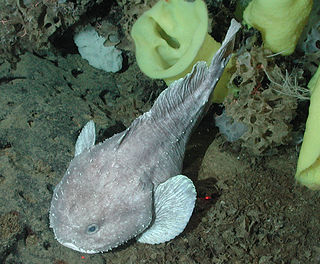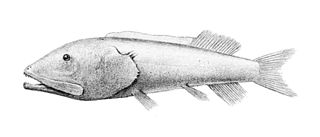
The Squaliformes are an order of sharks that includes about 126 species in seven families.

The cusk-eel family, Ophidiidae, is a group of marine bony fishes in the Ophidiiformes order. The scientific name is from the Greek ophis meaning "snake", and refers to their eel-like appearance. True eels diverged from other ray-finned fish during the Jurassic, while cusk-eels are part of the Percomorpha clade, along with tuna, perch, seahorses and others.

Slickheads, also known as nakedheads or smoothheads, are deep water fishes that belong to the family Alepocephalidae. They are most commonly found in the bathypelagic layer, which is approximately 3000m below the surface. They get their name from the lack of scales on their heads. Similarly, the scientific name is from the Greek ᾰ̓- (a-, "not"); λέπος (lepos, "scale"); and κεφαλή (kephalē, "head"). It has about 22 genera with ca. 96 species.

The Ipnopidae are a family of fishes in the order Aulopiformes. They are small, slender fishes, with maximum length ranging from about 10 to 40 cm. They are found in temperate and tropical deep waters of the Atlantic, Indian, and Pacific Oceans.

Ambassis is a genus of ray-finned fish in the family Ambassidae, the Asiatic glassfishes. They are found widely in the Indo-Pacific region, with species in fresh, brackish and coastal marine waters.

Psychrolutes is a genus of marine ray-finned fishes belonging to the family Psychrolutidae, the fatheads and toadfishes. Though found predominantly in the deep sea, a handful of species are present in the intertidal regions of the North Pacific rim. In June 2003, During the NORFANZ Expedition north-west of New Zealand, scientists trawled a specimen of P. microporos at a depth between 1,013 metres (3,323 ft) and 1,340 metres (4,400 ft) on the Norfolk Ridge.
Synodontis polyodon is a species of upside-down catfish native to Gabon where it occurs in the Ogowe River basin. It was first described by French zoologist Léon Vaillant in 1895, based upon a holotype discovered in the Ogooué River, near Adouma, Gabon. The specific name "polyodon" comes from the Greek words poly, meaning "many" and odon, meaning "tooth", referring to the many teeth in this species.

Fish are very diverse animals and can be categorised in many ways. Although most fish species have probably been discovered and described, about 250 new ones are still discovered every year. According to FishBase about 34,800 species of fish had been described as of February 2022, which is more than the combined total of all other vertebrate species: mammals, amphibians, reptiles and birds.

Alepocephalus is a genus of slickheads found in all oceans.

Bathytroctes is a genus of deepwater marine ray-finned fishes belonging to the family Alepocephalidae, the smooth-heads. These fishes are found in the deeper waters of the Oceans around the world..
Conocara is a genus of deepwater marine ray-finned fishes belonging to the family Alepocephalidae, the smooth-heads. These fishes are found in the deeper waters of the Oceans around the world.
Leptoderma is a genus of slickheads found in the deep waters of the oceans.
Mirognathus is a monospecific genus of deepwater maine ray-finned fish belonging to the family Alepocephalidae, the slickheads. The only species in the genus is Mirognathus normani, the beaked slickhead or Norman's smooth-head, which is found in the north-east and western Atlantic Ocean, the western Indian Ocean and the western Pacific Ocean. This species grows to a standard length of 20 centimetres (7.9 in).
Photostylus is a monospecific genus of deepwater maine ray-finned fish belonging to the family Alepocephalidae, the slickheads. The only species in the genus is Photostylus pycnopterus, the starry smooth-head, a species found in all oceans at depths of from 1,000 metres (3,300 ft) to 2,000 metres (6,600 ft). This species grows to a length of 11 centimetres (4.3 in) SL.
Rinoctes is a monospecific genus of deepwater maine ray-finned fish belonging to the family Alepocephalidae, the slickheads. The only species in the genus is Rinoctes nasutus, the abyssal smooth-head, which is found at depths of 2,000 metres (6,600 ft) to 4,156 metres (13,635 ft) in the Atlantic Ocean, and possibly in the Indian and Pacific Oceans. It grows to a length of 19 centimetres (7.5 in) SL.
Herwigia is a monospecific genus of deepwater maine ray-finned fish belonging to the family Alepocephalidae, the slickheads. The only species in the genus is Herwigia kreffti, or Krefft's smooth-head, a species found at depths of 1,000 to 3,200 metres in the oceans. This species grows to a length of 40 centimetres (16 in) SL.

Insidiator is a genus of marine, demersal ray-finned fish belonging to the family Platycephalidae. These fishes are native to the eastern Indian Ocean and western Pacific Ocean.

Liparis agassizii, in one instance called "agassiz's snailfish", is a species of marine ray-finned fish belonging to the family Liparidae, the snailfishes. It lives in the North Pacific Ocean at a depth range between zero and one hundred meters. The fish may especially be found from the Iwate Prefecture to Hokkaido, off the coast of Primorskiy, off the western and southeastern coast of Sakhalin, and in the southern Kuril Islands.
Leptochilichthys agassizii, or Agassiz' smooth-head, is a species of fish in the family Alepocephalidae. It is named for the scientist and engineer Alexander Agassiz (1835–1910), who commanded the 1899 survey aboard the USS Albatross on which the fish was discovered.

Vaillant's smooth-head is a species of deepwater marine ray-finned fish belonging to the family Alepocephalidae, the smooth-heads. This species is found in the Atlantic Indian and Western Pacific Oceans.











